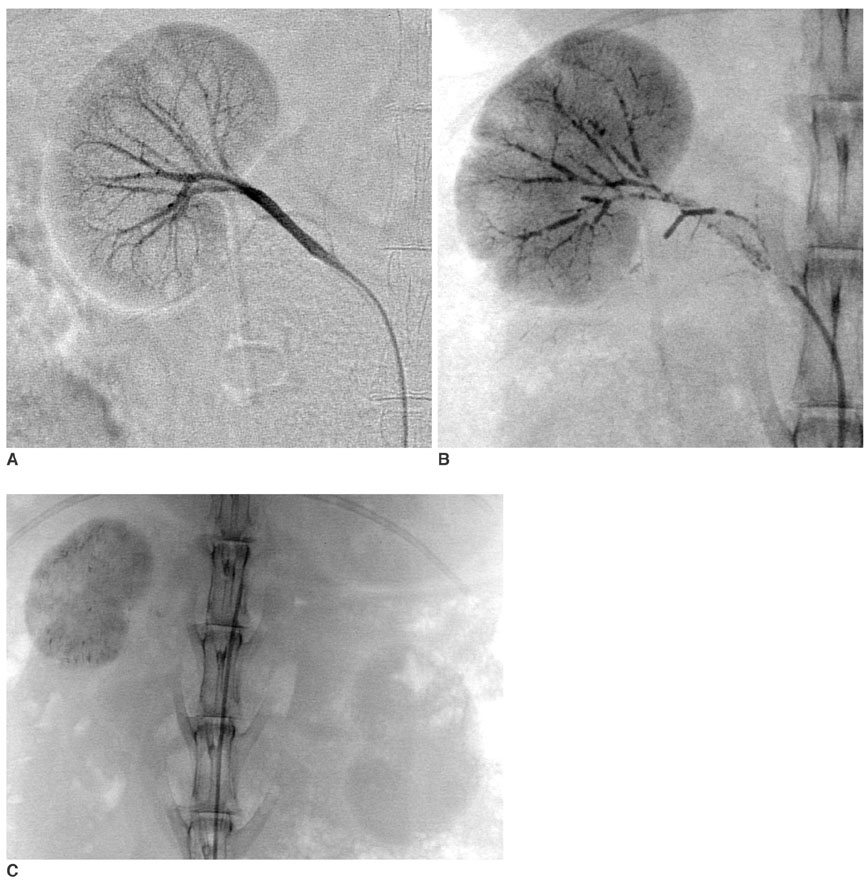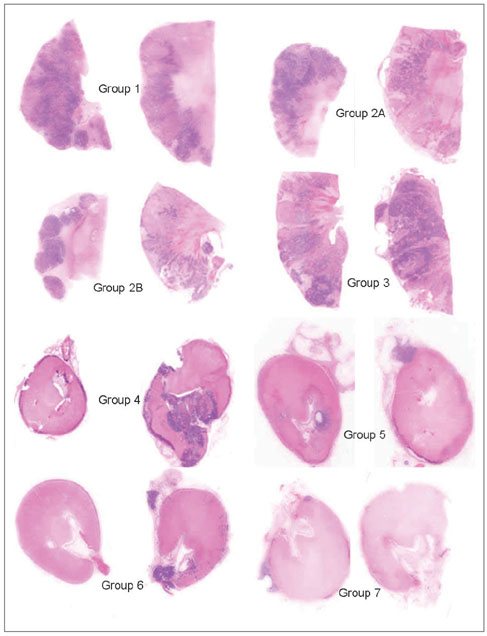Korean J Radiol.
2007 Apr;8(2):136-147. 10.3348/kjr.2007.8.2.136.
Transcatheter Arterial Embolization of Renal VX-2 Carcinoma: Ethiodol-Ethanol Capillary Embolization Combined with Carboplatin
- Affiliations
-
- 1Vascular and Interventional Radiology, Division of Diagnostic Imaging, Unit 057, The University of Texas MD Anderson Cancer Center, TX, USA. akonya@mdanderson.org
- 2Department of Radiology, Kangnam St. Mary's Hospital, College of Medicine, The Catholic University of Korea, Seoul, Korea.
- 3Department of Veterinary Medicine and Surgery, The University of Texas MD Anderson Cancer Center, TX, USA.
- KMID: 1126837
- DOI: http://doi.org/10.3348/kjr.2007.8.2.136
Abstract
OBJECTIVE
We wanted to determine whether transcatheter Ethiodol-based capillary embolization in combination with carboplatin could improve the efficiency of a 1:1 Ethiodol-ethanol mixture (EEM) to ablate kidneys that been inoculated with VX-2 carcinoma. MATERIALS AND METHODS: The right kidney in 34 New Zealand white rabbits were inoculated with fresh VX-2 tumor fragments. One week later, the kidneys were subjected to transarterial treatment (4-5 rabbits/group): Saline infusion (Group 1); carboplatin infusion (5 or 10 mg, Groups 2A and 2B); carboplatin-Ethiodol (CE) alone (Group 3) and followed by main renal artery occlusion with ethanol (RAO) (Group 4); carboplatin-EEM (C-EEM) followed by RAO (Group 5); carboplatin infusion followed by EEM plus RAO (Group 6); and EEM followed by RAO (Group 7). The animals were followed for up to 3-weeks. The treated kidneys were evaluated angiographically and macroscopically. The kidneys that showed successful embolization macroscopically were entirely cut into serial sections, and these were examined microscopically. Histologically, the kidneys were evaluated on the basis of the residual tumor found in the serial sections. RESULTS: The results obtained with carboplatin infusion alone (Groups 2A and 2B) and CE without RAO (Group 3) were similar to those of the control animals (Group 1). Kidneys from Groups 4-7 demonstrated macroscopically successful embolization with histologically proven complete renal parenchyma infarction; however, some residual tumor was evident in all but one animal. CONCLUSION: None of the Ethiodol-based modalities combined with locoregional carboplatin were more efficacious for tumor ablation than EEM alone.
Keyword
MeSH Terms
Figure
Cited by 1 articles
-
Transcatheter Arterial Embolization in Patients with Kidney Diseases: an Overview of the Technical Aspects and Clinical Indications
Romaric Loffroy, Pramod Rao, Byung-Kook Kwak, Shinichi Ota, Ming De Lin, Eleni Liapi, Jean-François Geschwind
Korean J Radiol. 2010;11(3):257-268. doi: 10.3348/kjr.2010.11.3.257.
Reference
-
1. Cobb WS, Heniford BT, Matthews BD, Carbonell AM, Kercher KW. Advanced age is not a prohibitive factor in laparoscopic nephrectomy for renal pathology. Am J Surg. 2004. 70:537–542.2. Murphy DP, Gill IS. Energy-based renal tumor ablation: a review. Semin Urol Oncol. 2001. 19:133–140.3. Gervais DA, Arellano RS, Mueller PR. Percutaneous radiofrequency ablation of renal cell carcinoma. Eur Radiol. 2005. 15:960–967.4. Yamakado K, Nakatsuka A, Kobayashi S, Akeboshi M, Takaki H, Kariya Z. Radiofrequency ablation combined with renal arterial embolization for the treatment of unresectable renal cell carcinoma larger than 3.5 cm: initial experience. Cardiovasc Intervent Radiol. 2006. 29:389–394.5. Lanigan D, Jurriaans E, Hammonds JC, Wells IP, Choa RG. The current status of embolization in renal cell carcinoma - a survey of local and national practice. Clin Radiol. 1992. 46:176–178.6. Zielinski H, Szmigielski S, Petrovich Z. Comparison of preoperative embolization followed by radical nephrectomy with radical nephrectomy alone for renal cell carcinoma. Am J Clin Oncol. 2000. 23:6–12.7. Craven WM, Redmond PL, Kumpe DA, Durham JD, Wettlaufer JN. Planned delayed nephrectomy after ethanol embolization of renal carcinoma. J Urol. 1991. 146:704–708.8. Klimberg I, Hunter P, Hawkins IF, Drylie DM, Wajsman Z. Preoperative angioinfarction of localized renal cell carcinoma using absolute ethanol. J Urol. 1985. 133:21–24.9. Imai S, Kajihara Y, Nishishita S, Hayashi T. Effect of ethanol induced occlusion of the renal artery in rabbit kidney implanted with VX2 carcinoma. Acta Radiol. 1989. 30:535–539.10. Ellman BA, Parkhill BJ, Curry TS 3rd, Marcus PB, Peters PC. Ablation of renal tumors with absolute ethanol: a new technique. Radiology. 1981. 141:619–626.11. Park JH, Jeon SC, Kang HS, Im JG, Han MC, Kim CW. Transcatheter renal arterial embolization with the mixture of ethanol and iodized oil (Lipiodol®). Invest Radiol. 1986. 21:577–580.12. Wright KC, Loh G, Wallace S, Stephens LC. Experimental evaluation of ethanol-ethiodol for transcatheter renal embolization. Cardiovasc Intervent Radiol. 1990. 13:309–313.13. Park JH, Han JK, Chung JW, Choi BI, Han MC, Kim YI. Superselective transcatheter arterial embolization with ethanol and iodized oil for hepatocellular carcinoma. J Vasc Interv Radiol. 1993. 4:333–339.14. Konya A, Wright KC. Capillary embolization using ethiodol-ethanol for complete renal ablation in Swine. Invest Radiol. 2002. 37:512–520.15. Konya A, Van Pelt CS, Wright KC. Ethiodized oil-ethanol capillary embolization in rabbit kidneys: temporal histopathological findings. Radiology. 2004. 232:147–153.16. Kónya A, Wright KC. Ethiodol-ethanol capillary embolization in rabbit kidney implanted with VX-2 carcinoma. Radiological Society of North America (RSNA) Scientific Assembly and Annual Meeting Program 2001. Radiology. 2001. 221(P):184.17. Pohlen U, Berger G, Binnenhei M, Reszka R, Buhr HJ. Increased carboplatin concentration in liver tumors through temporary flow retardation with starch microspheres (Spherex) and gelatin powder (Gelfoam): an experimental study in liver tumor-bearing rabbits. J Surg Res. 2000. 92:165–170.18. Buchta K, Sands J, Rosenkrantz H, Roche WD. Early mechanism of action of arterially infused alcohol U.S.P. in renal devitalization. Radiology. 1982. 145:45–48.19. Konya A, Stephens CL, Wright KC. A new transcatheter method for renal ablation: pure ethiodized oil is an efficient ablative agent. 2005. In : Radiological Society of North America (RSNA) Scientific Assembly and Annual Meeting Program; 409.20. Kauffmann GW, Richter GM, Rohrbach R, Wenz W. Prolonged survival following palliative renal tumor embolization by capillary occlusion. Cardiovasc Intervent Radiol. 1989. 12:22–28.
- Full Text Links
- Actions
-
Cited
- CITED
-
- Close
- Share
- Similar articles
-
- Renal Arterial Embolization in Metastatic Renal Cell Carcinoma with Absolute Ethanol
- Renal arterial embolization with absolute ethanol
- A Comparative Study on Transcatheter Renal Arterial Embolization (TRAE) in Rabbits with Absolute Ethanol and Gelfoam Particles
- Transcatheter arterial embolization for congenital renal arteriovenous fistula
- Percutaneous transcatheter embolization







